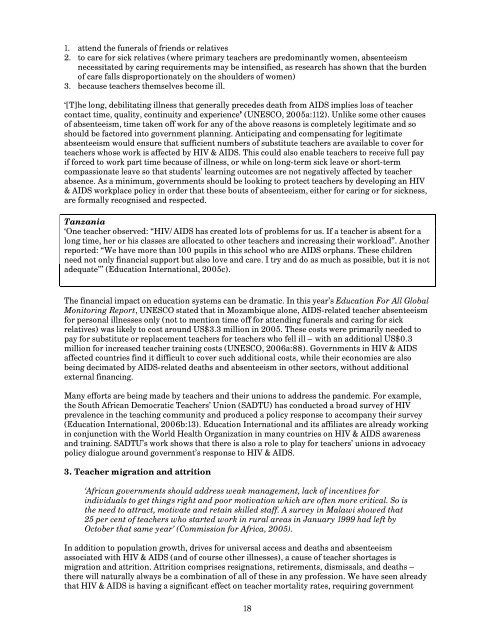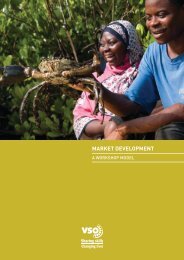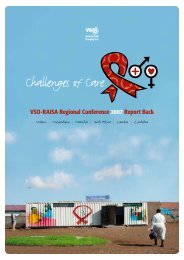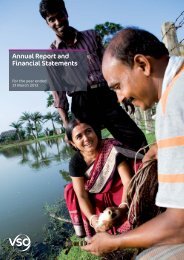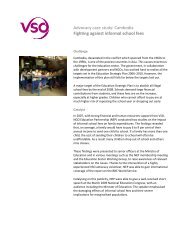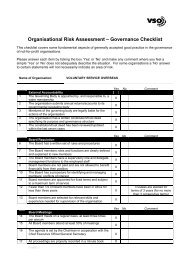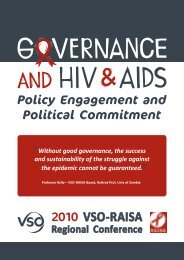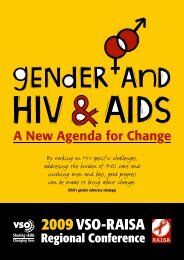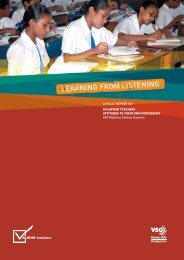Teachers for All â GCE policy briefing (566KB) - VSO
Teachers for All â GCE policy briefing (566KB) - VSO
Teachers for All â GCE policy briefing (566KB) - VSO
You also want an ePaper? Increase the reach of your titles
YUMPU automatically turns print PDFs into web optimized ePapers that Google loves.
1. attend the funerals of friends or relatives2. to care <strong>for</strong> sick relatives (where primary teachers are predominantly women, absenteeismnecessitated by caring requirements may be intensified, as research has shown that the burdenof care falls disproportionately on the shoulders of women)3. because teachers themselves become ill.‘[T]he long, debilitating illness that generally precedes death from AIDS implies loss of teachercontact time, quality, continuity and experience’ (UNESCO, 2005a:112). Unlike some other causesof absenteeism, time taken off work <strong>for</strong> any of the above reasons is completely legitimate and soshould be factored into government planning. Anticipating and compensating <strong>for</strong> legitimateabsenteeism would ensure that sufficient numbers of substitute teachers are available to cover <strong>for</strong>teachers whose work is affected by HIV & AIDS. This could also enable teachers to receive full payif <strong>for</strong>ced to work part time because of illness, or while on long-term sick leave or short-termcompassionate leave so that students’ learning outcomes are not negatively affected by teacherabsence. As a minimum, governments should be looking to protect teachers by developing an HIV& AIDS workplace <strong>policy</strong> in order that these bouts of absenteeism, either <strong>for</strong> caring or <strong>for</strong> sickness,are <strong>for</strong>mally recognised and respected.Tanzania‘One teacher observed: “HIV/AIDS has created lots of problems <strong>for</strong> us. If a teacher is absent <strong>for</strong> along time, her or his classes are allocated to other teachers and increasing their workload”. Anotherreported: “We have more than 100 pupils in this school who are AIDS orphans. These childrenneed not only financial support but also love and care. I try and do as much as possible, but it is notadequate’’’ (Education International, 2005c).The financial impact on education systems can be dramatic. In this year’s Education For <strong>All</strong> GlobalMonitoring Report, UNESCO stated that in Mozambique alone, AIDS-related teacher absenteeism<strong>for</strong> personal illnesses only (not to mention time off <strong>for</strong> attending funerals and caring <strong>for</strong> sickrelatives) was likely to cost around US$3.3 million in 2005. These costs were primarily needed topay <strong>for</strong> substitute or replacement teachers <strong>for</strong> teachers who fell ill – with an additional US$0.3million <strong>for</strong> increased teacher training costs (UNESCO, 2006a:88). Governments in HIV & AIDSaffected countries find it difficult to cover such additional costs, while their economies are alsobeing decimated by AIDS-related deaths and absenteeism in other sectors, without additionalexternal financing.Many ef<strong>for</strong>ts are being made by teachers and their unions to address the pandemic. For example,the South African Democratic <strong>Teachers</strong>’ Union (SADTU) has conducted a broad survey of HIVprevalence in the teaching community and produced a <strong>policy</strong> response to accompany their survey(Education International, 2006b:13). Education International and its affiliates are already workingin conjunction with the World Health Organization in many countries on HIV & AIDS awarenessand training. SADTU’s work shows that there is also a role to play <strong>for</strong> teachers’ unions in advocacy<strong>policy</strong> dialogue around government’s response to HIV & AIDS.3. Teacher migration and attrition‘African governments should address weak management, lack of incentives <strong>for</strong>individuals to get things right and poor motivation which are often more critical. So isthe need to attract, motivate and retain skilled staff. A survey in Malawi showed that25 per cent of teachers who started work in rural areas in January 1999 had left byOctober that same year’ (Commission <strong>for</strong> Africa, 2005).In addition to population growth, drives <strong>for</strong> universal access and deaths and absenteeismassociated with HIV & AIDS (and of course other illnesses), a cause of teacher shortages ismigration and attrition. Attrition comprises resignations, retirements, dismissals, and deaths –there will naturally always be a combination of all of these in any profession. We have seen alreadythat HIV & AIDS is having a significant effect on teacher mortality rates, requiring government18


